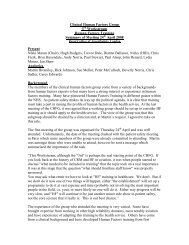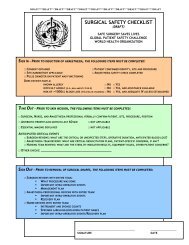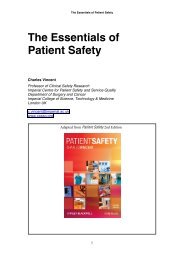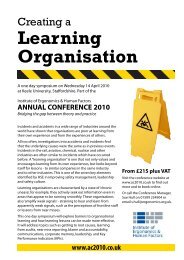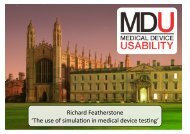Read an anonymous version of Elaine's report, the Inquest Verdict ...
Read an anonymous version of Elaine's report, the Inquest Verdict ...
Read an anonymous version of Elaine's report, the Inquest Verdict ...
Create successful ePaper yourself
Turn your PDF publications into a flip-book with our unique Google optimized e-Paper software.
Conclusions <strong>an</strong>d suggested actionsAs is clear from <strong>the</strong> <strong>report</strong>, I believe that Mrs Bromiley suffered severe cerebral damageas a result <strong>of</strong> her extended period <strong>of</strong> hypoxia subsequent upon <strong>the</strong> unexpected difficultyin maintaining her airway during <strong>an</strong>aes<strong>the</strong>sia.The staff <strong>an</strong>d facilities at The xx Clinic are <strong>of</strong> a high st<strong>an</strong>dard. There is a good level <strong>of</strong>equipment in <strong>the</strong> hospital to deal with difficult airways. The only piece <strong>of</strong> equipment notavailable at <strong>the</strong> time <strong>of</strong> my visit in May was <strong>an</strong> Aintree Ca<strong>the</strong>ter. It would be prudent toprovide this piece <strong>of</strong> equipment.Suggested action: Purchase <strong>of</strong> Aintree Ca<strong>the</strong>ter for use in difficult intubationThe pre-operative assessment <strong>an</strong>d <strong>an</strong>aes<strong>the</strong>tic m<strong>an</strong>agement was <strong>of</strong> <strong>an</strong> appropriatest<strong>an</strong>dard as was <strong>the</strong> choice <strong>of</strong> <strong>an</strong>aes<strong>the</strong>tic technique <strong>an</strong>d drugs.The initial airway m<strong>an</strong>agement was appropriate <strong>an</strong>d in keeping with acceptable practice.The m<strong>an</strong>agement <strong>of</strong> <strong>the</strong> „c<strong>an</strong>‟t intubate, c<strong>an</strong>‟t ventilate‟ situation did not follow <strong>the</strong>accepted Difficult Airway Society guidelines. In particular too much time was taken intrying to intubate <strong>the</strong> trachea ra<strong>the</strong>r th<strong>an</strong> concentrating on ensuring adequate oxygenationby o<strong>the</strong>r me<strong>an</strong>s such as direct access to <strong>the</strong> trachea. Whilst <strong>the</strong>atre staff ensured that allnecessary equipment was available, <strong>the</strong> clinici<strong>an</strong>s appeared to become oblivious to <strong>the</strong>passing <strong>of</strong> time <strong>an</strong>d thus lost opportunities to limit <strong>the</strong> extent <strong>of</strong> damage caused by <strong>the</strong>prolonged period <strong>of</strong> hypoxia. Given <strong>the</strong> skill mix <strong>of</strong> <strong>the</strong> clinici<strong>an</strong>s, it would have beenvery easy to perform a surgical procedure to gain access to <strong>the</strong> trachea. Theatre staff,when interviewed, all seemed surprised that such was not performed. Suggested action:Ensure <strong>an</strong> atmosphere <strong>of</strong> good communication in <strong>the</strong> operating <strong>the</strong>atre such that <strong>an</strong>ymember <strong>of</strong> staff feels comfortable to make suggestions on treatment.The Difficult Airway Society guidelines are fairly new (2004) <strong>an</strong>d it may be useful tohave copies <strong>of</strong> <strong>the</strong>m on display in <strong>the</strong> <strong>an</strong>aes<strong>the</strong>tic rooms to act as a prompt should such <strong>an</strong>event occur again.Suggested action: Obtain <strong>an</strong>d display a set <strong>of</strong> <strong>the</strong> latest DAS guidelines in each<strong>an</strong>aes<strong>the</strong>tic roomGiven <strong>the</strong> problem with time passing unnoticed, should such <strong>an</strong> event occur again, amember <strong>of</strong> staff should be allocated to record timings <strong>of</strong> events <strong>an</strong>d keep all involvedaware <strong>of</strong> <strong>the</strong> elapsed time.Suggested action: Develop a protocol to ensure that when <strong>an</strong>y emergency event occurs,be it in <strong>the</strong> <strong>an</strong>aes<strong>the</strong>tic room or <strong>the</strong> operating <strong>the</strong>atre, <strong>the</strong>re is someone designated to keepfull contempor<strong>an</strong>eous records <strong>of</strong> <strong>the</strong> event <strong>an</strong>d to provide <strong>an</strong> elapsed time prompt. It wasclear that clinici<strong>an</strong>s were not entirely familiar with some <strong>of</strong> <strong>the</strong> particular peculiarities <strong>of</strong>some <strong>of</strong> <strong>the</strong> equipment used. This might be rectified by a study day on difficult airwaym<strong>an</strong>agement for all staff including clinici<strong>an</strong>s.15



